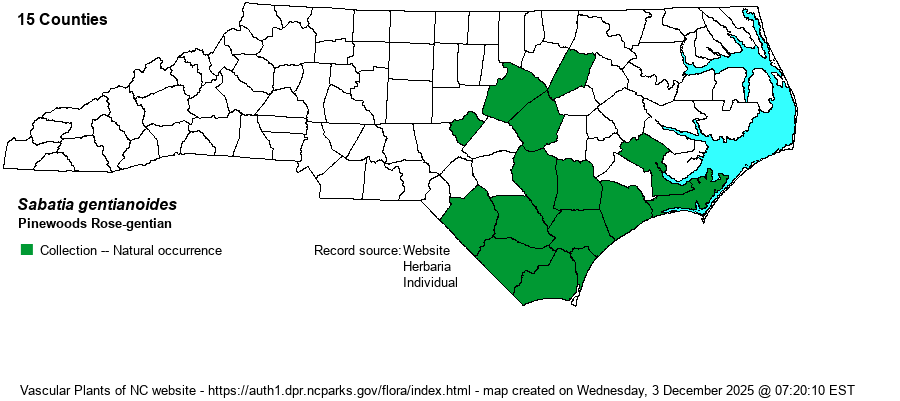| Author | Elliott | |
| Distribution | Essentially limited to the southern third of the Coastal Plain, but not ranging west to the Sandhills region except in southern Lee County. Ranges north to Johnston and Lee counties in the Coastal Plain, and to Nash and Wake counties along the Fall Line.
This is a Coastal Plain species, ranging from eastern NC south to northern FL, and west to eastern TX. | |
| Abundance | Locally fairly common in well-managed Longleaf Pine (Pinus palustris) stands. However, generally uncommon over the range away from such pine forests. Very rare to rare north of Sampson County. | |
| Habitat | This species is mainly limited to pine savannas, particular those with frequent prescribed burns. It also grows in wet powerline clearings that mimic savannas, as well as in wetter portions of pine flatwoods. | |
| Phenology | Blooms in July and August, and fruits from September to October. | |
| Identification | This may be the brightest and richest rose-colored flower you can find in NC savannas, one of the state's most beautiful wildflowers. It has an erect stem to about 1.5-2 feet tall, with either an unbranched stem or with only a very few small and erect branches. Basal leaves may be present at flowering, and these are fairly wide, but the paired stem leaves are linear, about 3-4 inches long but barely 1/8-inch wide. The large flowers that top the stem and any branches are almost sessile, with very short pedicels; if more than one flower is present at a branch or stem tip, they are in a compact cluster. Each flower has a bright to deep rose color, rarely "just pink", with a yellow base, about 10 (to rarely 12) petals in all, and the spread flower is about 2 inches across. The only species to potentially confuse with it -- S. dodecandra and S. kennedyana -- have solitary flowers (one per branch or stem) on fairly long pedicels, well above the stem and branches. Also, these occur in different habitats -- the former in tidal marshes, and the latter in Waccamaw River floodplain wetlands, whereas S. gentianoides occurs in savannas. S. kennedyana and S. gentianoides could potentially occur in close proximity, but the first one has single flowers on long pedicels, whereas the latter has sessile flowers, often 2-5 in a tight cluster. | |
| Taxonomic Comments | None
| |
| Other Common Name(s) | None | |
| State Rank | S3 | |
| Global Rank | G4G5 | |
| State Status | | |
| US Status | | |
| USACE-agcp | OBL link |
| USACE-emp | OBL link |

